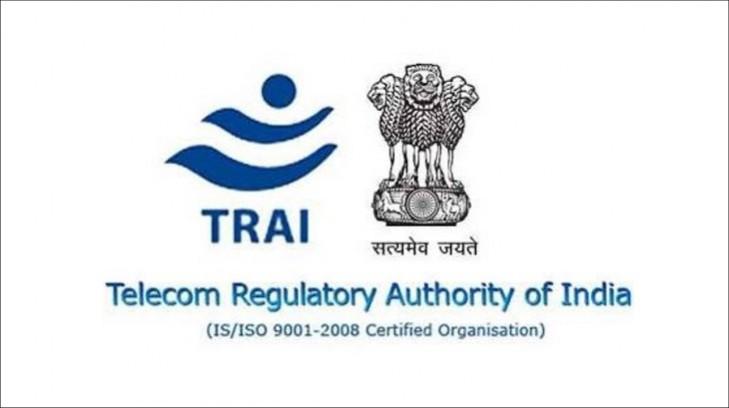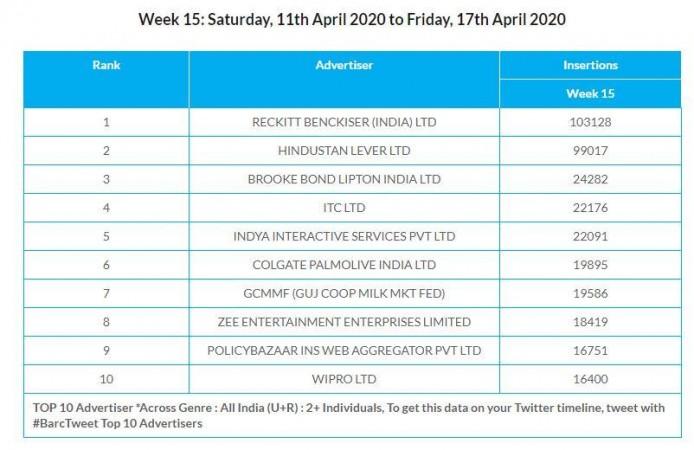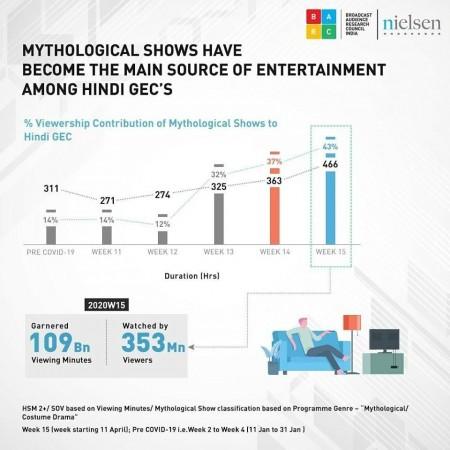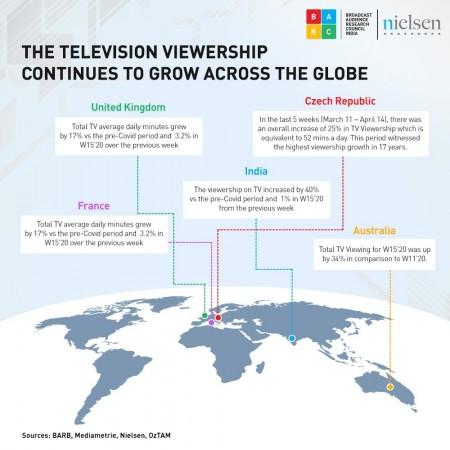The television rating system in India requires a major revamp, says Telecom Regulatory Authority of India (TRAI). Today, it issued a slew of recommendations for the 'Review of Television Audience Measurement and Rating System in India.'
Telecom Regulatory Authority of India (TRAI) gave its recommendations to the Ministry of Information and Broadcasting (MIB) on August 19, 2008, covering various aspects including the need for the Government to regulate the system of television ratings.

TRAI also recommended the approach of self-regulation by setting up an industry-led body, the Broadcast Audience Research Council (BARC). TAM Media Research became the sole provider of Television Rating services on a commercial basis, as Audience Measurement and Analytics Ltd. (aMAP) discontinued its services.
How does audience measurement and TRP system work in India?
Audience measurement implies what is being viewed by large audiences, and on the basis of this data, ratings are assigned to various programs broadcasted on television. The TV ratings, in turn, influence the programs produced for the viewers and highlight the content in demand by TV audiences. MIB notified policy guidelines for television rating agencies on January 10, 2014. As per these guidelines, the industry-led body BARC was accredited by MIB on July 28, 2015, to carry out the television ratings in India.
BARC is an industry-led body represented by the Indian Broadcasting Foundation (IBF), the Indian Society of Advertisers (ISA) and the Advertising Agencies Association of India (AAAI). BARC India commenced its operations in 2015 and since then it is the sole provider of Television Rating services on a commercial basis. BARC India is a not-for-profit company under Section 25 (now Section 8) of the Companies Act, with the prime objective of providing ratings to Television channels
In 2019, India's Television industry grew from Rs 74,000 crore to Rs 78,700 crore with 60% revenue generated through distribution and 40% from the advertisement. As per the industry estimates broadcasters' revenue increased from Rs 41,300 crore to Rs 45,000 crore in 2019, of which the advertising revenue is approx. 70% and subscription revenue is approximately 30%.
Out of the overall broadcasters' revenue of Rs. 45,000 crore in 2019, Rs.32,000 crore was collected from advertising revenues. This underlines the dependence of the industry on the flow of advertisement revenues, which, in turn, largely hinges upon the profile of their audience, and the popularity of their content, which is assessed through Television Audience Measures and Rating. This is why it is imperative that the process of TAM and TRP should be objective, fair, neutral, and transparent. For the same reason, the process of TAM and TRP engages continued attention from the Sector Regulators, leading to periodical reviews and reforms. In India, TRAI has been suggesting measures to refine the system from time to time.

Various stakeholders have now raised concerns on the neutrality and reliability of the existing TV rating system, which necessitated TRAI to conduct a review on the TAM and rating system in India. TRAI has come up with a slew of recommendations to mitigate potential conflict of interest, improve credibility, bring in transparency and instil confidence in the TAM and TRP measurement system in India.
TRAI recommendations for BARC
As IBF nominated representatives of 6 major broadcasters as the non-executive directors controlling effectively all policies/rules of the BARC. BARC is not just involved in framing methodology, validation rules and audit mechanism of measurement, but also involved in the collection of data, processing of the data and publishing the rating. Structural reforms are required in the governance structure of BARC India to mitigate the potential risk of conflict of interest, improve credibility, bring in transparency and instil confidence of all stakeholders in the TRP measurement system in India.
TRAI further noted that IBF, AAAI and ISA are declared as 60:20:20 shareholders of BARC in order to portray it as an industry body, but, in fact, 100% shares are held by IBF. Further, IBF holds 100% shareholding with a share capital of Rs. 15 lakhs. This implies that IBF has full control over BARC from making policies/Rules to the collection of data, etc. This can naturally raise the question of credibility and neutrality of the measurement system.

Also out of the ten members on BARC's Board – six are broadcasters/large players, which could mean that the system is skewed in favour of broadcasters or large players. Though all directors on the Board are nonexecutive directors, they are not independent as all of them have a potential conflict of interest in the rating system.
Hence, as a part of the proposed structural reforms in BARC, the composition of the board of BARC India must be changed to comprise of at least 50 per cent independent members - to include one measurement technology expert, a statistician of national repute from top institutions of the country, and two representatives from the government or the regulator (TRAI). The number of members in the technical committee should be increased to 5 with the addition of two external technical experts.
It is recommended that the restructured board of BARC India should provide for equal representation of three constituent industry associations namely - AAAI, ISF and IBF along with equal voting rights irrespective of their proportion of equity holding in BARC India. The tenure of members on the board shall be two years. Active participation of the representatives of the advertisers and the advertising agency will bring in more accuracy, transparency, credibility and neutrality in the TAM and TRP system, in view of the inherent need of advertisers to reach viewers accurately.
In order to bring in more transparency and neutrality in the Television audience ratings' system in the country, it is important to minimize the scope of any potential conflict of interest. Therefore, measures like having a more inclusive decision-making body, which denies a position of majority/undue influence to any stakeholder group, enjoy a representation of Government/regulatory bodies, etc. help in making the audience rating measurement bodies more neutral, transparent and credible.
Apart from a more inclusive Board for the BARC, TRAI is also of the view that a broad-based Oversight Committee with experts from related fields should include representations from National Council of Applied Economic Research, IIT, IIM, media research expert and demography expert, a nominee from the Ministry of Information & Broadcasting and TRAI should be set up. This committee will be responsible for the nomination and appointment of independent members of the Board as well as to give policy direction to BARC India, as and when required.
The constituent Industry Associations shall be entitled to nominate their representatives to the board membership subject to the condition that a cooling period of 4 years shall be applicable between two consecutive tenures, for any such nominee member. Further, the tenure of the Chairman of the Board should not be more than two years and the chairmanship shall be entrusted in rotation among the constituent industry associations every two years.

Will multiple agencies entry into TRP measurement system help?
Considering BARC is the only agency providing the rating services in India, it arises a situation of monopolistic authority, thus invariably raising questions on the account of the market behaviour, quality of service, and cost inefficiencies. The entry of more players and the resultant increased competition could perhaps contain and curb the ill effects of market dominance by BARC, leading to a better quality of service and reduced costs.
However, at the same time, setting up credible and transparent rating services would require substantial capital investments, that has to be ultimately borne by the 13 stakeholders. Multiple agencies will lead to an increased cost of operations passed on to the broadcasters and ultimately to the end-users/ consumers, also there will be a conflict of data as different agencies will have different data samples from households they cater to.
Looking at the positive side of entry of more rating service agencies will increase competition to bring in new technologies, new research methodologies, new methods in analysis, and new and better ways to ensure better data quality. In a monopolistic arrangement, there is absolutely no driver for BARC to improve, invest, and upgrade the process with the changing demand of times. So, the competition will push BARC to introduce neutrality and fairness as manipulation in ratings will be easy to detect. Thus the need for multiple rating agencies or otherwise is under deliberation by the regulator TRAI.
BARC India and TAM India have formed a joint venture called Meteorology Data Pvt Ltd (MDL) to set up a meter management company. In MDL, BARC India has management control with a 51 per cent stake, while TAM India – which includes Nielsen and Kantar –has a 49 per cent stake. The role of MDL is to run and manage the meter operations and supplying raw data to BARC India. Television Viewership data is being disseminated through BMW (BARC India Media Workstation). MDL is managing the panel households and is also responsible for future Television panel expansions.
The majority stake of BARC in MDL, helps them exercise control over its data collection operations. The current scenario of a single entity holding control over the policy formulation, methodology, data collection, data processing and publication in India, does not leave much scope for a new player to enter into the field of measurement of Television rating or for collecting the data.
Will healthy competition between BARC and new rating agencies help?
In an era of big data and artificial intelligence, TRAI is of the view that healthy competition will bring in more brains to the business and expand measurement from a 'sample-based model' to a 'census-based model' by allowing multiple players in data collection. This will gradually enhance accuracy of the ratings as well.
It is required of BARC to maintain an arm's length from its own subsidiary, Meterology Data Pvt Ltd., which is the sole data collecting agency for BARC, as of now; so that the entire process of measurement is carried out independently to ensure inherent checks in data inconsistency, i.e., there should be a clear demarcation of the roles between the data collection agency and the data processing/publishing agency. Also, efforts will be made to withhold the identity of the channel's name, and number, while collecting and processing the data from the field to bring more transparency in the complete process.
As per TRAI recommendations, BARC is required to separate its functions in two units (a) one unit should be responsible for prescribing methodology of ratings/validation of data, publishing the data and audit mechanism and (b) the other unit for processing the data, watermarking or any other such technical work including management of data collection agencies.
If multiple agencies come forward for rating, TRAI expects BARC to limit its role to publishing the ratings, and framing methodology and audit mechanism for the rating agencies, so that the number of agencies can develop multiple rating systems leveraging new technologies.
The rating agency should be mandated to increase the sample size from current 44,000 to 60,000 by the end of 2020 and to 1,00,000 by 2020 with the use of advanced technology. Financial disincentives should be prescribed as per panel provisions including the cancellation of registration if the specified target is not met by BARC. MIB should amend the DTH license and MSO registration, so as to mandate STBs capable of transferring viewership data and adoption of RPD technology.

Decoding the viewership data right
Anonymised viewership data should be transferred electronically to the Audience measurement agency for statistical analysis and television rating purposes. BARC India is also trying to introduce new technologies such as Audio matching, which will reduce dependency on the broadcasters, and will also be cost-effective. RPD is a cost-effective solution for a market and will reduce the fear factor of households while installing separate meters and will make every STB into a barometer.
There is an urgent need to either supplement a system with RPD (Return Path Data) or have an independent RPD-based currency, which can ensure that the system will be able to provide robust estimates for smaller channels as well as reduce the influence of tampered households on overall ratings. No data from any STB should be transferred to the Rating agency without explicit consent from the subscribers. DPOs should be allowed to mutually negotiate the terms and conditions for sharing the data with the Measurement Rating agency within the overall framework prescribed by TRAI from time to time.
As rating becomes currency for the advertisers for their expenditure, the security of data is of utmost importance in the whole system. Irrespective of the technology used, sample size or agency responsible for rating the system, the security of data should not be compromised at any stage. Hence, TRAI is of the view that rating agencies should explore new technologies that can increase the sample size in a cost-effective manner, build confidence in the rating published by the agency.
It is required of BARC to keep all relevant data such as original data (meter-level data) arising out of the household panel, the data deleted/ignored/not considered for ratings and the resultant processed data for TRP rating at least for one year in the same format and pattern as in the final ratings, declared to the subscribers including Broadcasters, advertising agencies, and advertisers.
BARC should automate data processing in such a manner that no manual intervention is required before the final TRP rating is released. Any type of manual intervention in the meter-level /raw data arising out of the household panel must be avoided. Manual intervention, if any, in abnormal circumstances should be reported and informed to the auditors.
Need for grievance redressal and annual audits at BARC
BARC should develop a portal wherein any stakeholder can raise the grievance(s) with regards to ratings published by the agency.
BARC should get an annual audit conducted by an independent agency to ensure conformance with TRP rating methodology, sample size, and grievance redressal methodology and publish the audit report on their website after the Board's approval within three months, after the end of the financial year.
Quarterly reports of the internal audit committee consisting of heads of AAAI and ISA will audit processes, methodologies and practices must be approved by the Board of BARC within 30 days from the end of the quarter and be posted on the BARC website.

















